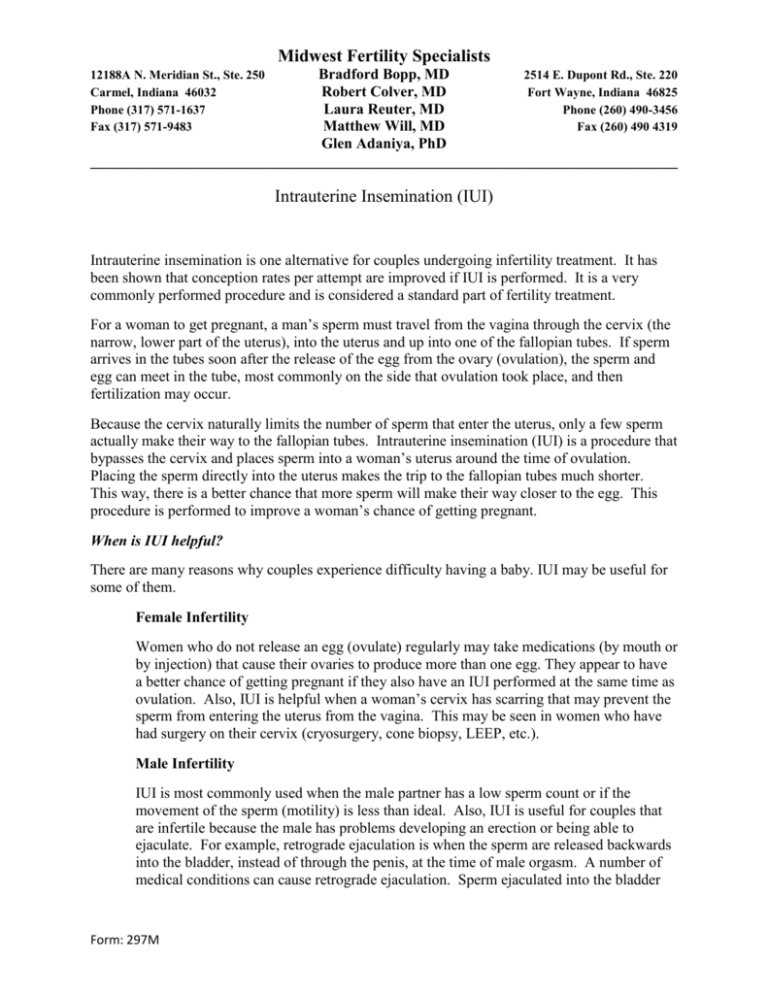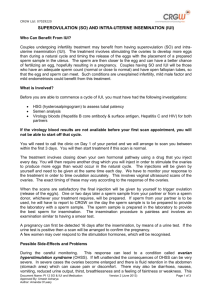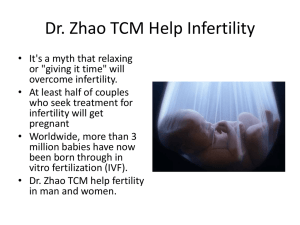Intrauterine Insemination (IUI) Intrauterine insemination is one
advertisement

Midwest Fertility Specialists Bradford Bopp, MD 2514 E. Dupont Rd., Ste. 220 Robert Colver, MD Fort Wayne, Indiana 46825 Laura Reuter, MD Phone (260) 490-3456 Matthew Will, MD Fax (260) 490 4319 Glen Adaniya, PhD ______________________________________________________________________________ 12188A N. Meridian St., Ste. 250 Carmel, Indiana 46032 Phone (317) 571-1637 Fax (317) 571-9483 Intrauterine Insemination (IUI) Intrauterine insemination is one alternative for couples undergoing infertility treatment. It has been shown that conception rates per attempt are improved if IUI is performed. It is a very commonly performed procedure and is considered a standard part of fertility treatment. For a woman to get pregnant, a man’s sperm must travel from the vagina through the cervix (the narrow, lower part of the uterus), into the uterus and up into one of the fallopian tubes. If sperm arrives in the tubes soon after the release of the egg from the ovary (ovulation), the sperm and egg can meet in the tube, most commonly on the side that ovulation took place, and then fertilization may occur. Because the cervix naturally limits the number of sperm that enter the uterus, only a few sperm actually make their way to the fallopian tubes. Intrauterine insemination (IUI) is a procedure that bypasses the cervix and places sperm into a woman’s uterus around the time of ovulation. Placing the sperm directly into the uterus makes the trip to the fallopian tubes much shorter. This way, there is a better chance that more sperm will make their way closer to the egg. This procedure is performed to improve a woman’s chance of getting pregnant. When is IUI helpful? There are many reasons why couples experience difficulty having a baby. IUI may be useful for some of them. Female Infertility Women who do not release an egg (ovulate) regularly may take medications (by mouth or by injection) that cause their ovaries to produce more than one egg. They appear to have a better chance of getting pregnant if they also have an IUI performed at the same time as ovulation. Also, IUI is helpful when a woman’s cervix has scarring that may prevent the sperm from entering the uterus from the vagina. This may be seen in women who have had surgery on their cervix (cryosurgery, cone biopsy, LEEP, etc.). Male Infertility IUI is most commonly used when the male partner has a low sperm count or if the movement of the sperm (motility) is less than ideal. Also, IUI is useful for couples that are infertile because the male has problems developing an erection or being able to ejaculate. For example, retrograde ejaculation is when the sperm are released backwards into the bladder, instead of through the penis, at the time of male orgasm. A number of medical conditions can cause retrograde ejaculation. Sperm ejaculated into the bladder Form: 297M can be taken from the urine and used for IUI. Also, IUI may help if the male has an abnormal urethral opening (opening of the penis). How are sperm collected? The sperm needed for IUI can be collected in several ways. Most commonly, the man masturbates into a sterile plastic cup that is provided by the doctor’s office. Sperm can also be collected during sex in a special condom that the office provides. If a man has retrograde ejaculation the sperm can be retrieved in the laboratory from urine he has collected. Men who have a difficult time with erection or ejaculation despite using medications, as well as men with a spinal cord injury, may be able to produce a sperm sample with the help of procedures such as vibratory stimulation or electroejaculation. These procedures would commonly take place under direction of a urologist specializing in male fertility. How is IUI done? Once collected, the semen sample is then “washed” in the laboratory, to concentrate the sperm and remove the seminal fluid. Seminal fluid would cause severe cramping in the woman if injected into the uterus. This process can take up to 2 hours to complete. IUI is performed near the time that the female partner is ovulating. The IUI procedure is relatively simple and only takes a few minutes. The woman lies on an exam table and the clinician inserts a speculum into her vagina to see her cervix. A catheter (narrow tube) is inserted through the cervix into the uterus and the washed semen sample is slowly injected. Usually this procedure is painless, but some women have mild cramps. After the procedure she will rest on the table for 10 minutes prior to leaving. There are no activity or intercourse restrictions after the procedure. Does it work? The success of IUI depends on the cause of the couple’s infertility. IUI works best for men when the sperm motility is low and for women whose cervix prevents sperm from entering their uterus. It does not work as well for men who produce fewer sperm. It also does not help women who have severe fallopian tube disease, moderate to severe endometriosis, or a history of pelvic infections. Other fertility treatments are better for these patients. Overall, if inseminations are performed monthly with fresh or frozen sperm, success rates can be as high as 20% per cycle depending on whether fertility medication are used, age of the female partner and infertility diagnosis, as well as other factors that could impact the success of the cycle. Are there risks? If a woman is taking fertility medication when undergoing IUI, her chance of getting pregnant with twins or triplets is greater than if she were not taking fertility medications. The chance of birth defects in all children is 2% to 4%. Undergoing an IUI does not increase that risk. The risk of developing an infection after an IUI is minimal, but symptoms would include fever, discharge or pain. Form: 297M









